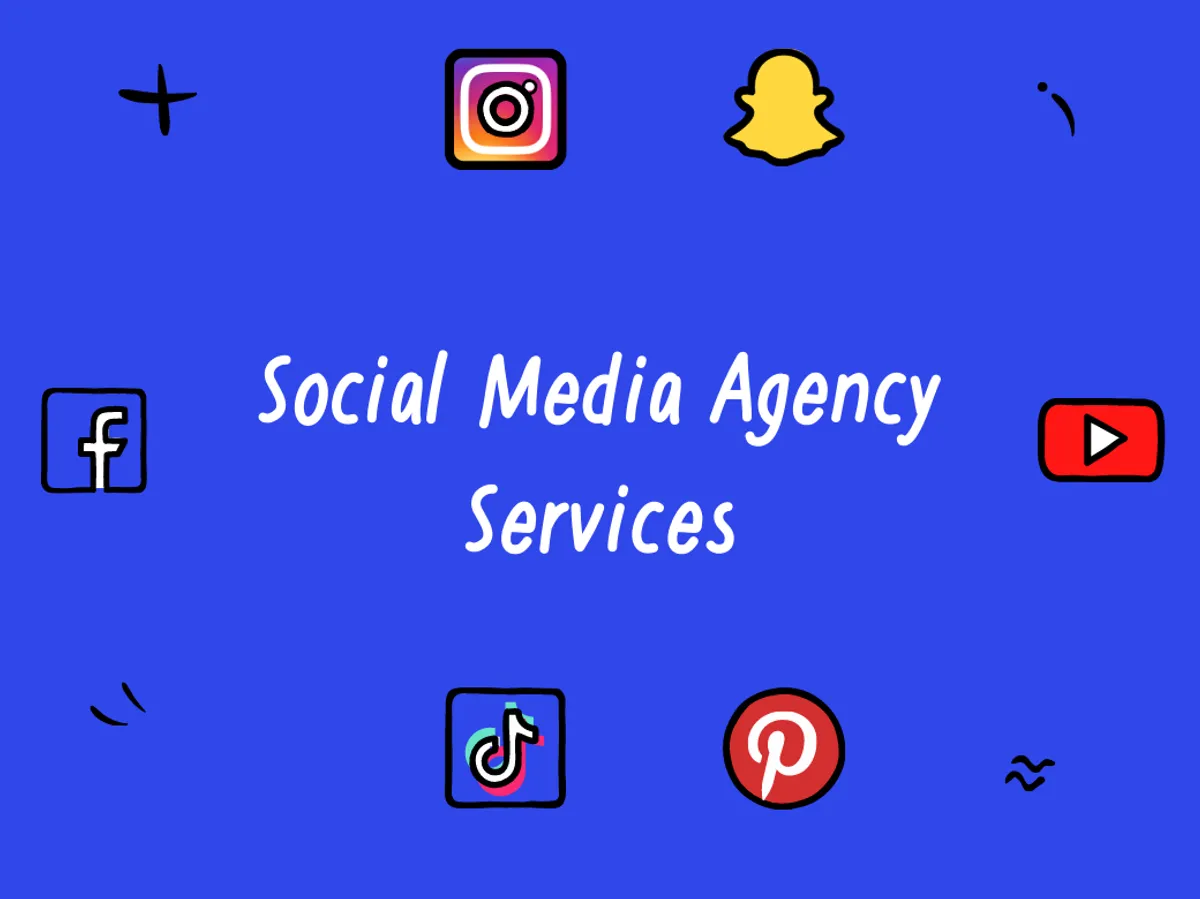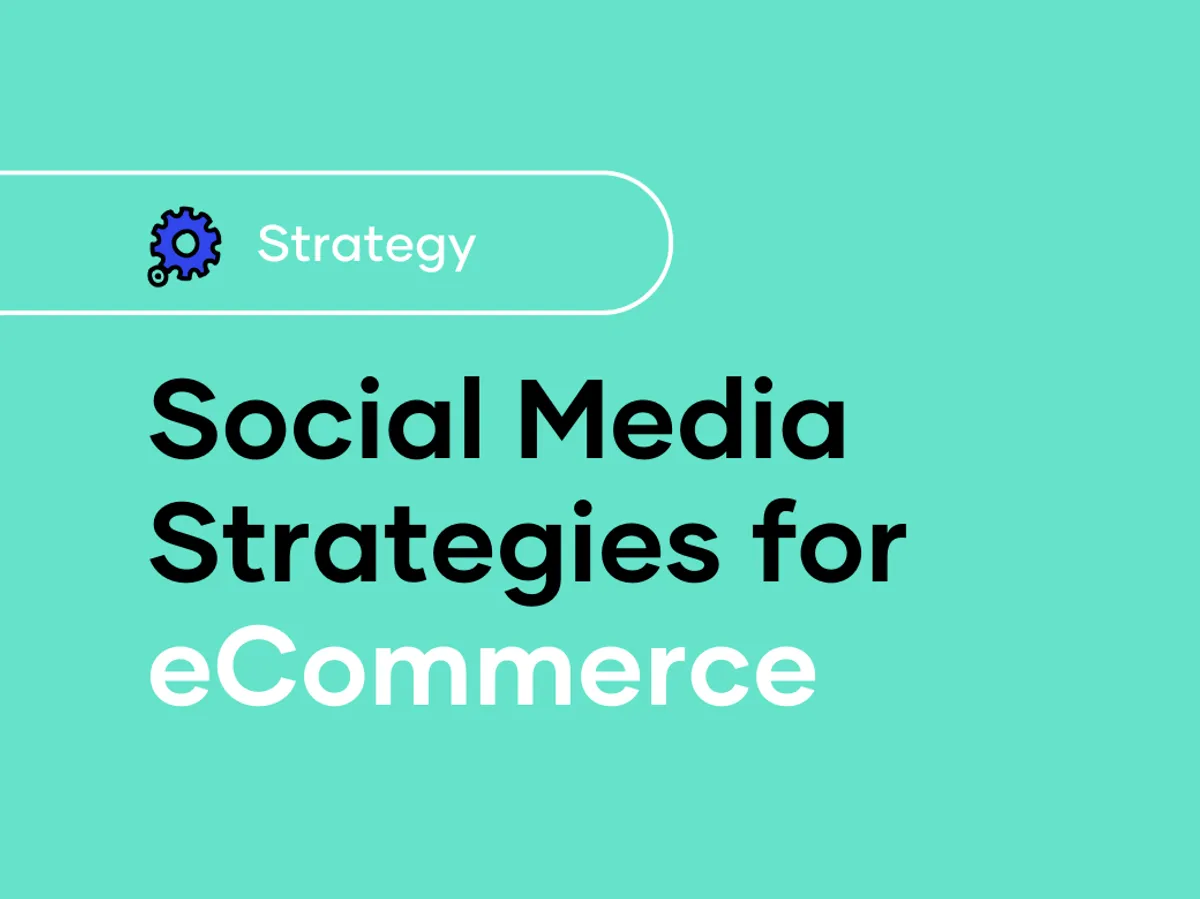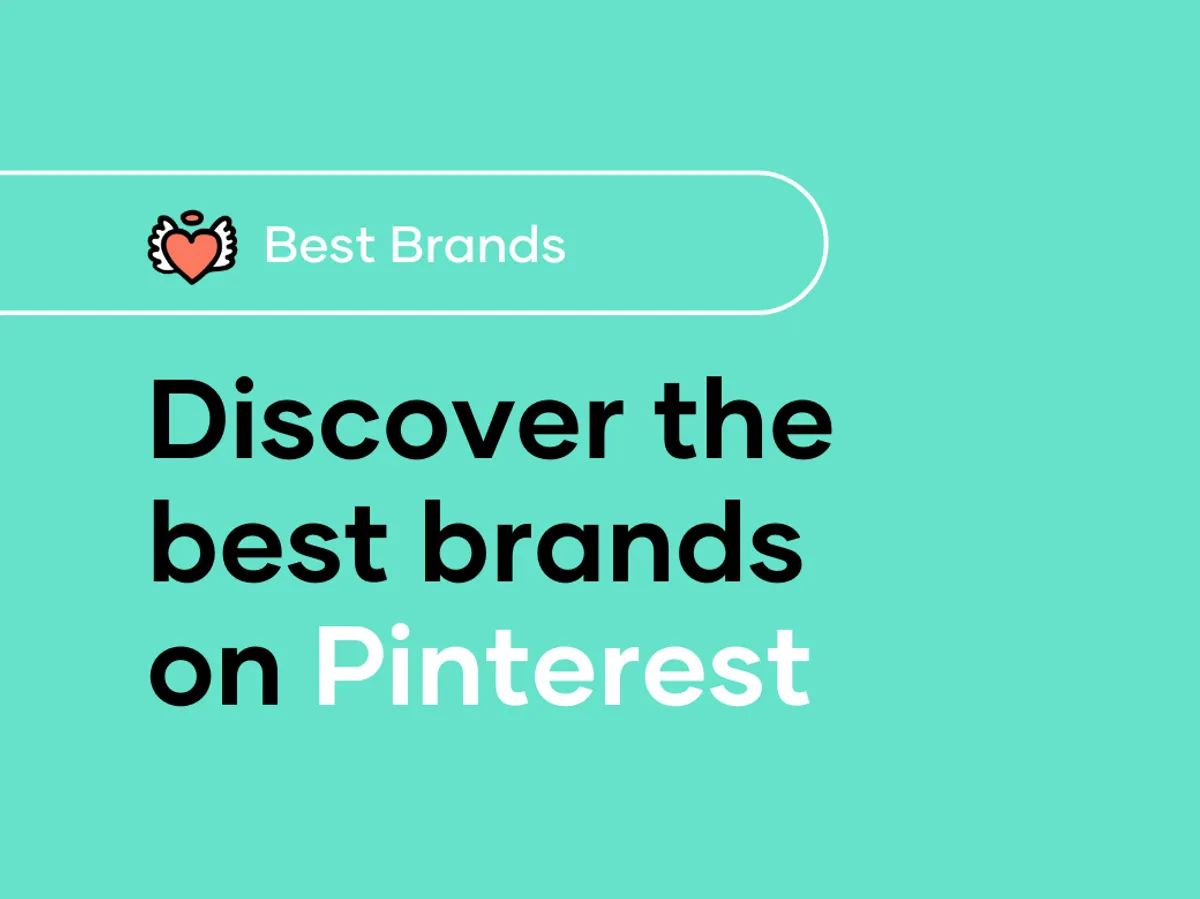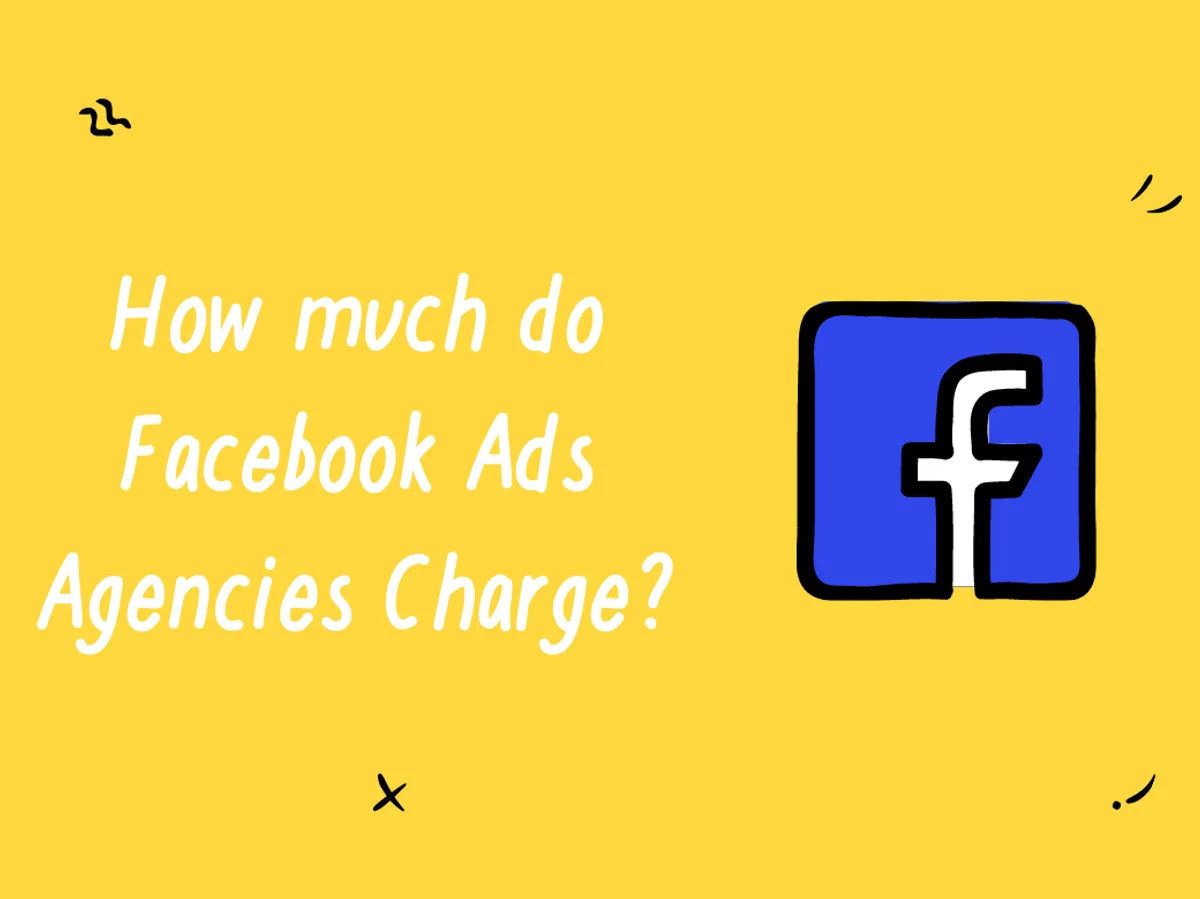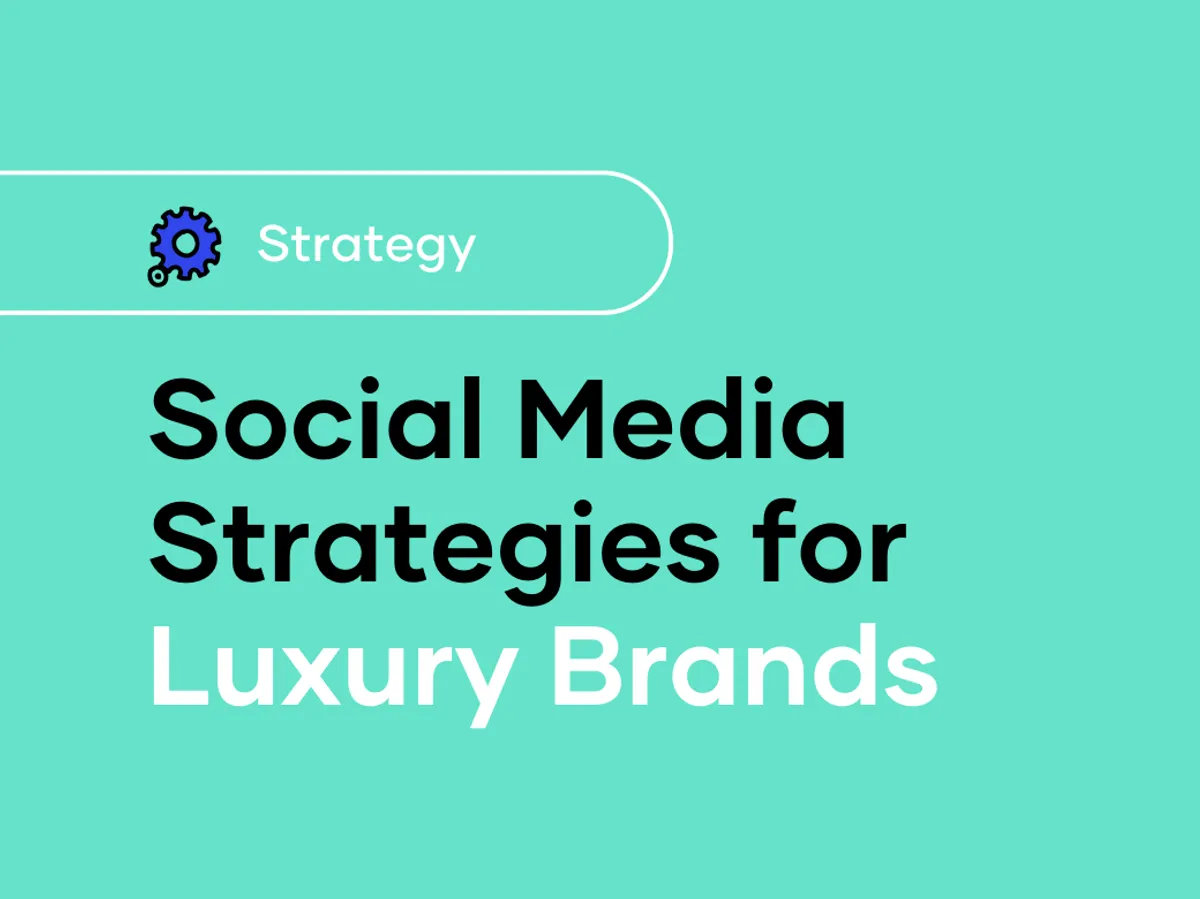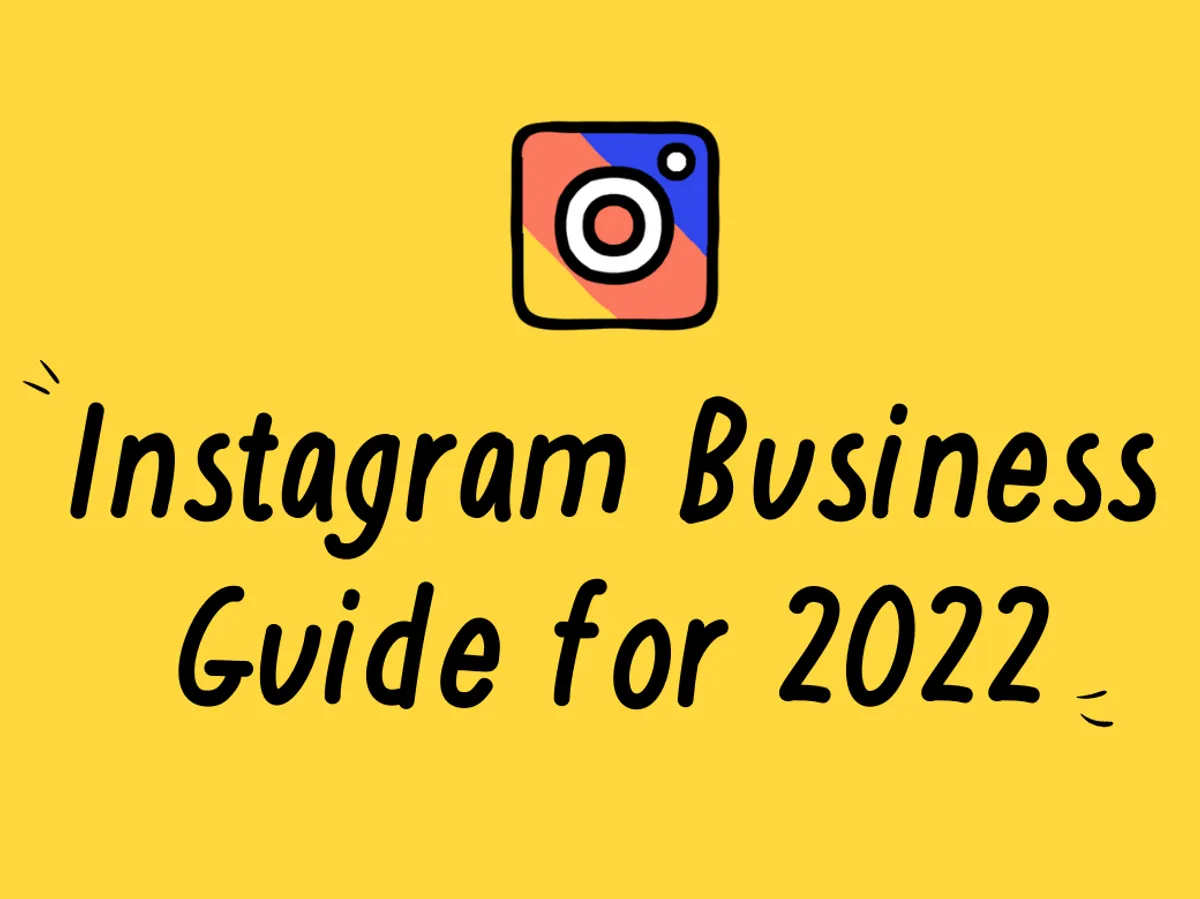Social Media Marketing for Fashion Brands: A Strategy That Works (with Examples)

Contents
Fashion’s pivot to online retail isn’t slowing down any time soon. Data shows that 28.8% of UK fashion sales take place online—up from 20% in 2019. The industry as a whole saw 5.7% year-over-year growth in 2021.
While it might not sound like much, fashion’s move to eCommerce isn’t set to slow down anytime soon. By 2025, experts predict that revenue from UK fashion brands will fall just shy of $40 billion.
Social media plays a huge role in how web users find your fashion brand’s site. With a sound strategy—that can often include paid ads—you can successfully funnel social media users towards your website to purchase clothes.
Stay up to date
Why do fashion brands need a social media strategy?
In many ways, fashion brands go hand in hand with lifestyle and can often become a culturally driven product. When you mesh that with social media, it’s an effective way for consumers to find products within a social context. Yet, there are additional reasons why fashion brands must consider a solid social media strategy.
Build brand awareness
As a fashion brand, it’s paramount to constantly ask, “How can we get our customers to know, like, and trust us so we can build brand loyalty?”
Building brand awareness is an important first step in that process. According to the Influencer Marketing Hub Benchmark Report, as many as 69% of marketers use social media to create brand awareness. And 52% use it to increase web traffic.
Consumers can’t buy from you if they aren’t aware of your product offering. Being consistent about establishing your presence on social media channels changes that.
Get influencer support
One of the most effective ways for brands to get social media influencer support—whether it happens organically or through a paid partnership—is with an already established presence on social platforms.
The more strategic your brand is about increasing visibility, the more it can score strategic partnerships that work to increase traffic, revenue, and a recurring customer base.
About 51% of UK marketers are already working with influencers. In fact, two of the most mentioned fashion brands on platforms like TikTok in the UK are Shein and PrettyLittleThing. As a fashion brand, the bid for influencer support can’t be ignored.
Drive website traffic
According to a UK Statista survey, 25.6% of industry professionals say social media is the most effective digital marketing channel.
One of the most known perks of having a sound social media strategy is the access to cost-effective traffic that you wouldn’t have access to otherwise. Driving traffic—especially if you’re a younger brand—can be an uphill climb through channels other than social media.
For instance, if you choose to go the SEO route with content marketing, it can take anywhere from six months to a year to see any real results. Even if you eventually do see results, you have less control over what those outcomes will be.
10 key elements of a fashion brand social media strategy
There’s more to social media than posting content and hoping it resonates with your target audience. Posting content for content’s sake doesn’t move the needle as much as you’d hope.
You need a strategy in place—a plan of action that helps zone in on what you post across social media to meet the goals you’re setting for your fashion business. Followers, engagement, and sales are easier to generate when you’ve got a strategy to influence them.
So, what does that strategy look like? Here are 10 steps you can take to create yours.
1. Choose the right platforms
Every social media platform has potential customers in it. But some are more conducive to sales than others. According to Statista, some of the best places to learn about, discover or buy fashion apparel are Facebook and Instagram.
Since Facebook (now Meta) owns Instagram, it doesn’t take much extra work to execute an effective ad campaign for both platforms from the Facebook Ads Manager.
There are over 48 million UK users on Facebook. About four in ten Facebook users claim to discover fashion inspiration on the platform. In other words, the opportunity to engage a new audience and create brand loyalty on Facebook’s platform is too big to be ignored.
It’s also key to note that, according to Facebook, its platform is a key place to target 18-34-year-old fashion buyers. Specifically, women claim to draw fashion inspiration from influencers and celebrities on the platform.
Facebook’s survey found that Instagram is the number one place to discover fashion products. By preparing a fashion social media strategy that focuses on this platform, you’re in with a shot at reaching 28 million Instagram users in the UK.
So, what type of content should you share on Instagram? Research shows that mobile-created story ads tend to outperform highly produced ads on Instagram.
To add, if you’re going the advertising route on Instagram, don’t forget to include a call-to-action on your Instagram Stories. This type of ad—one with a CTA—tends to perform better 89% of the time.
YouTube
While smaller eCommerce brands are generally better off executing Facebook ads (especially if you’re working with a smaller budget), it’s worth noting that larger fashion industry brands like Chanel, with over 1.9 million subscribers, and Louis Vuitton, with 909,000 subscribers, are huge players on YouTube.
Each luxury fashion brand dominates the space by creating organic content through their own YouTube channels instead of only using paid ads.
Even if you are going the YouTube advertising route, a report by Strike Social found the average cost per view on YouTube is $0.026, while the average view rate is 31.9%.
Snapchat
Snapchat lends itself to storyselling through Snap Ads and Story Ads. While just 14% of Snapchat users use the social media platform to discover new products, more than a quarter purchase when they see something they like.
As for content formats, Snap Inc. reports that Discover content commercials increase ad awareness by as much as 65%, alluding to the effectiveness of video ads on the platform.
TikTok
While TikTok is the new kid on the block in more ways than one, it shouldn’t be ignored as a possible avenue for revenue generation. Your fashion brand might have to take a more native approach to ad creation with video content. But the time investment is worth it: more than a billion people use the platform.
Pinterest is a visual social media platform where users “Pin” items to virtual boards. Native shopping pins—those saved to Pinterest from a website—unlock a new way for savvy brands on Pinterest to get their products in front of fresh eyes.
The best part? According to data released by Pinterest, 70% of users discover new products on its platform, a whopping 90% say Pinterest helps them decide what to purchase, and as many as 66% of its users buy something after seeing a brand’s pins.
2. Create Instagram and Facebook Shops
Instagram and Facebook Shops are storefronts where users can view, browse, and buy products without leaving either social media app. Once you create them for your fashion brand, your audience can shop for your products directly on Instagram or Facebook.
Take Sweaty Betty, for example. Its Instagram Shop allows followers to natively shop products within its profile.
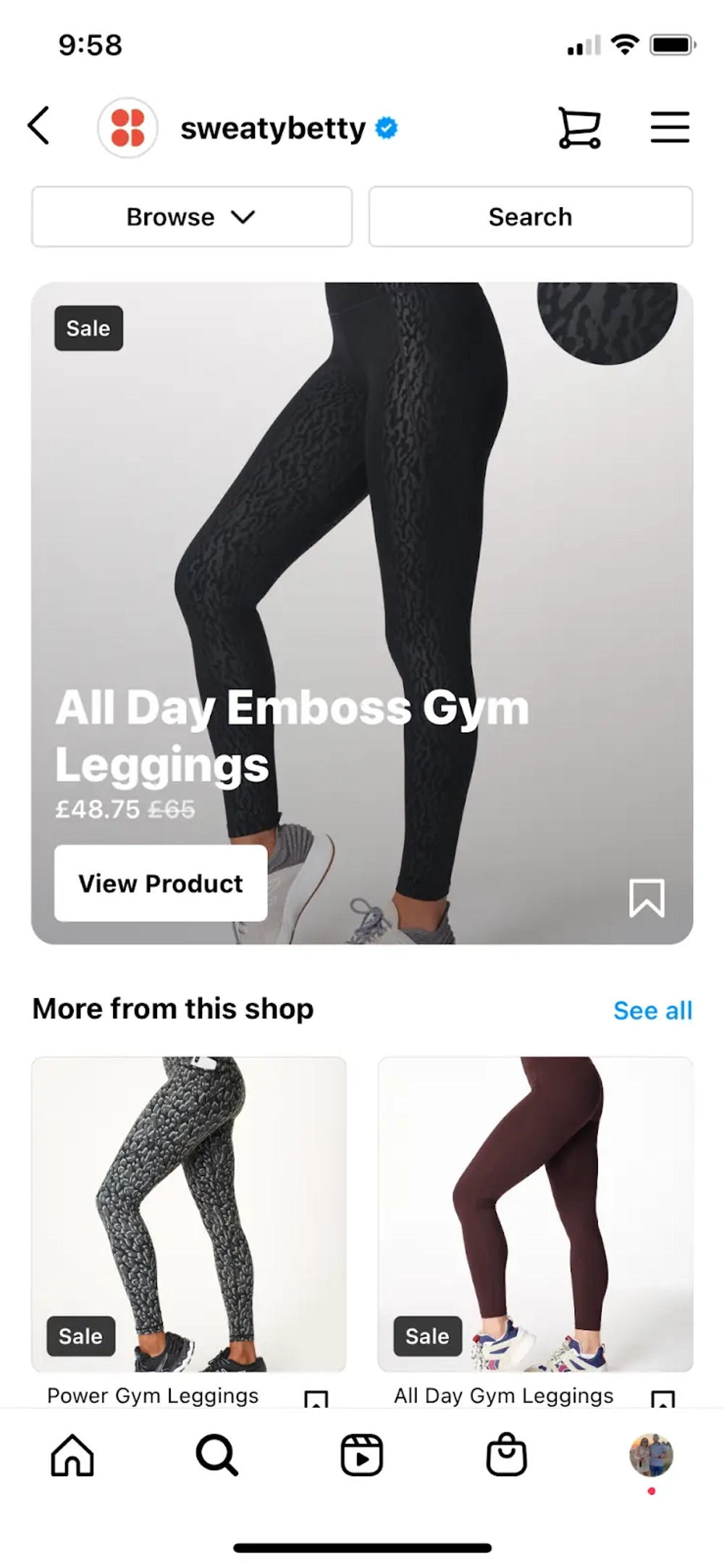
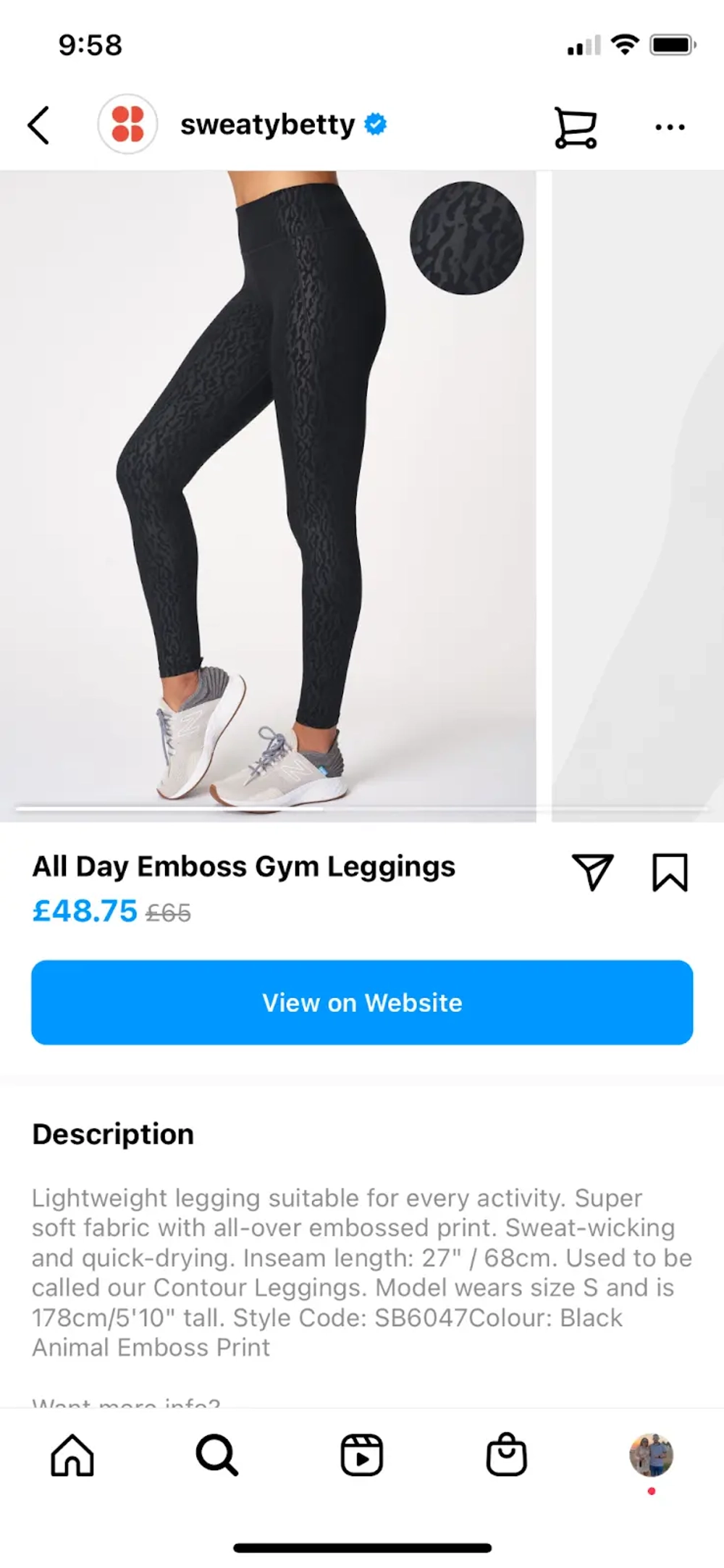
To create an Instagram and Facebook Shop, make sure your Instagram page has been converted into a business account and is connected to a Facebook page. From there, you’ll need to verify eligibility.
Once that’s accounted for, the setup steps are simple:
Head to your Commerce Manager and click Next.
Choose your checkout method (Shopify, through Facebook or Instagram, through your website, or through messaging) and click Next.
Connect your Facebook Business Page, your Instagram business account, your Business Manager, and your product catalogue.
Finally, review the Seller Agreement and click on Finish Setup to publish your shop.
From there, you can create a collection, add new products, or change the look of your catalogue.
Once you’ve got your Shop set up, don’t leave it to chance and expect visitors to your business profile will browse items through the in-app storefront. Create new content for either platform and tag items from your Shop. Data shows that 130 million people click on this kind of Instagram shopping post every month.
That way, followers can discover new fashion products, click through and buy them in just a few clicks.
3. Create a consistent posting schedule
Many brands struggle with consistency, especially when they’re trying to get traction. Yet, it’s a necessary element for an effective approach to a sound social strategy—whether you're keen on creating Instagram stories, IGTV videos, TikToks, or Instagram posts.
Not convinced? Consider this: Fashion brands that posted 0.96 posts on Instagram per day generated a 0.68% engagement rate per post—a higher engagement rate than on Facebook or Twitter.
Along with consistency, get clear on what to post. Choose a mix of these four content types when sharing fashion content on social media:
Promote: This content promotes your product with direct-response content and strong CTAs. The end goal is to have someone purchase your clothing, like Pretty Little Thing does with its Shop Instagram highlight reel.
Educate: Educational content teaches social media users about your product and shows them the “why” behind your brand. In other words, why does your brand exist? Is it inclusion? Is it fun? This Instagram post by Missguided, for example, educates people on how to recreate Halloween costumes.
Inspire: Use your brand personality and mission to stir emotion, tell stories, and create a connection with your ideal customers. Inspire them with relatable content. TopShop expertly does this by sharing seasonal content that tells a story around its apparel.
Entertain: Associate your brand with fun by creating content that entertains. Reel in your audience with creative content that doesn’t come with a hard sell. Here’s an example from UK brand Boohoo.
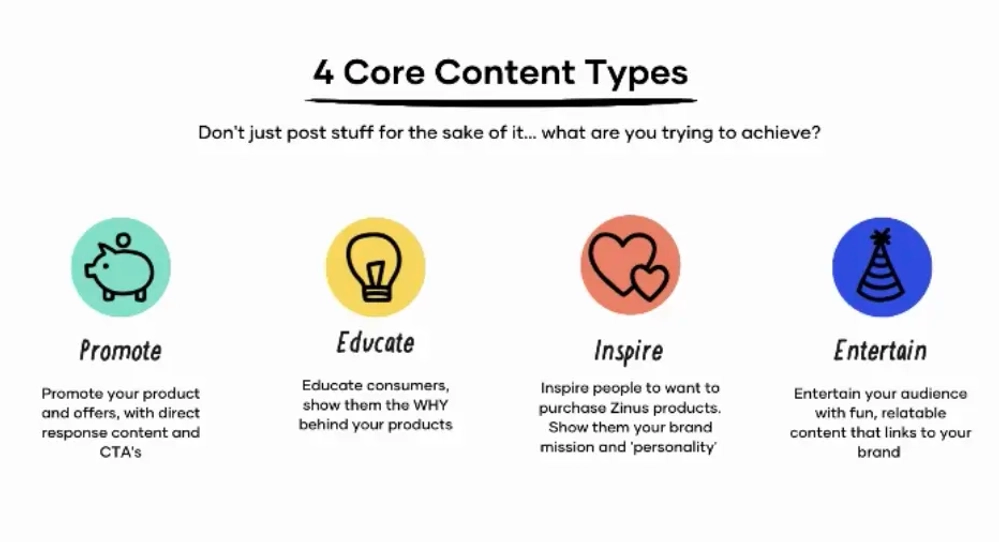
Once you know the type of content you need to create, it begs the question of how much you should be creating of each. For that, we have a handy chart that can work as a loose guideline for your own process as you learn and course-correct along the way on each platform.
Certain platforms lend themselves to different content types. Educational videos lend themselves to YouTube; promotional content is well-suited to a fashion brand’s Instagram feed.
But if you’re working on content for TikTok, remember that successful content on the platform follows trends. UK influencers with the highest engagement rates on TikTok, @hollyh and @abbyroberts, create content that doesn’t take itself too seriously—and most importantly, isn’t directly selling anything.
If you take any clues from these creators, skip hard promotion and go for 40% inspirational content, 20% educational content, and 40% entertainment content. If you see that a certain type of content is performing exceptionally well, that’s when it’s time to double down on what’s already working.
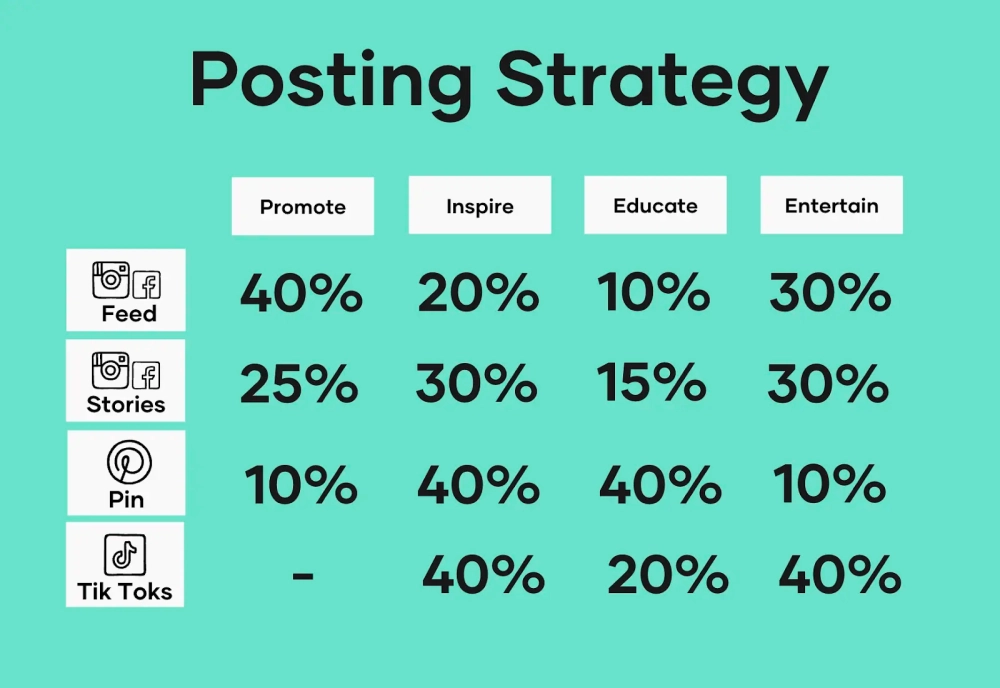
4. Invest in influencer marketing
Did you know that the global fashion influencer market has been valued at $1.5 billion, with an expected 35.7% growth rate by 2027? This can only mean one thing: spend time identifying influencers that your target audience follows.
Draw up a list of pros, cons, and average prices for the different types of influencers:
Nano: Influencers with fewer than 5,000 followers. They tend to be the cheapest to partner with but have the most engaged audiences.
Micro: Influencers with 5,000-20,000 followers.
Mid-tier: Influencers with 20,000-100,000 followers.
Macro: Influencers with 100,000-1 million followers.
Celebrity: Influencers with more than a million followers.
Regardless of the popularity of each influencer on your shortlist, remember that follower count isn’t the most important metric. Ideally, you’re looking for influencers with high engagement rates on their content (it means they’re likely to trust the fashion brand the influencer recommends), and an audience whose interests overlap with your target customer.
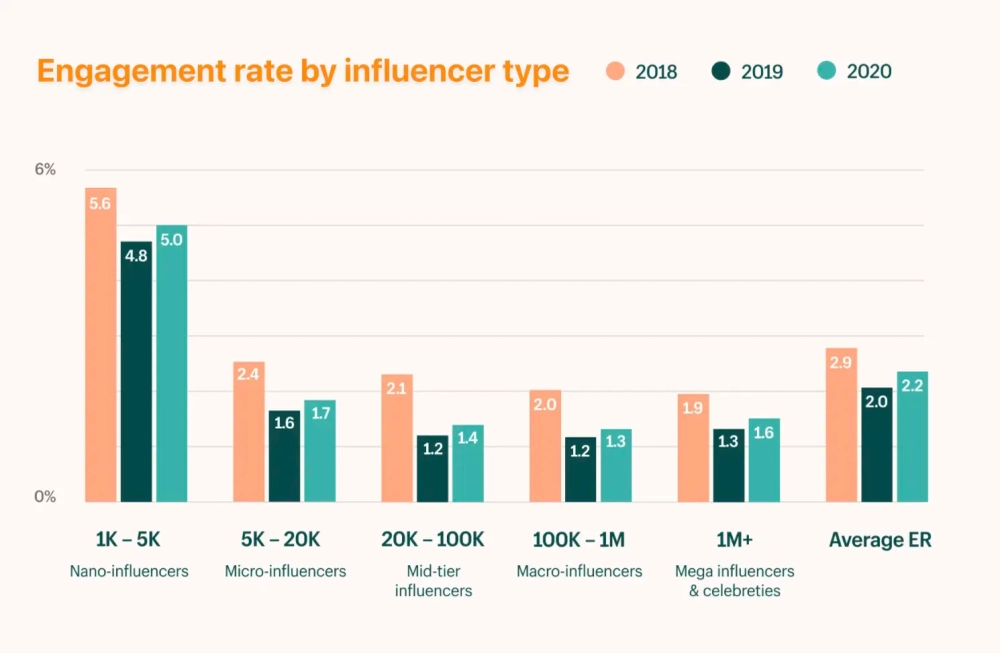
Once you’ve found your influencer, cultivate mutually beneficial partnerships with them. You could send them free clothes, pay to sponsor a post, or give their audience a discount code to encourage website visits.
Here’s an example of a sponsored Instagram Story by a Gymshark sponsored influencer, @beatseb, who has more than 120,000 followers. The post garnered thousands of likes and plenty of comments.

TikTok can also work if you take the sponsored post or influencer collaboration route. By partnering with TikToker @kyletheyuan, who has over 350,000 followers, Levi’s tapped into an existing fanbase and got endorsed by an influencer they trust.

5. Repost customer content
User-generated content (UGC) is a powerful way to both get your product in front of potential customers and increase engagement through a more organic approach. Instead of creating content yourself, your fashion brand can encourage existing customers to post photos and videos of themselves wearing your apparel—then repost that to your profile.
This type of social media content works because 73% of shoppers say UGC increases their purchasing confidence. Not only that, but about 61% of shoppers in the same consumer study claimed UGC encourages them to interact with brands.
Consider that fashion brands have an almost 5% higher average star rating than other industries. This already gives you something to work with as you increase consumer trust and get the sales flywheel going when visitors see your reviews on your product pages.
Take Gucci’s approach to creators mocking its brand online, for example. Its #Guccimodelchallenge got creators to compete by creating the best Gucci look possible. The result? A widespread challenge created tonnes of UGC content that the brand repurposed and featured on its own TikTok page.
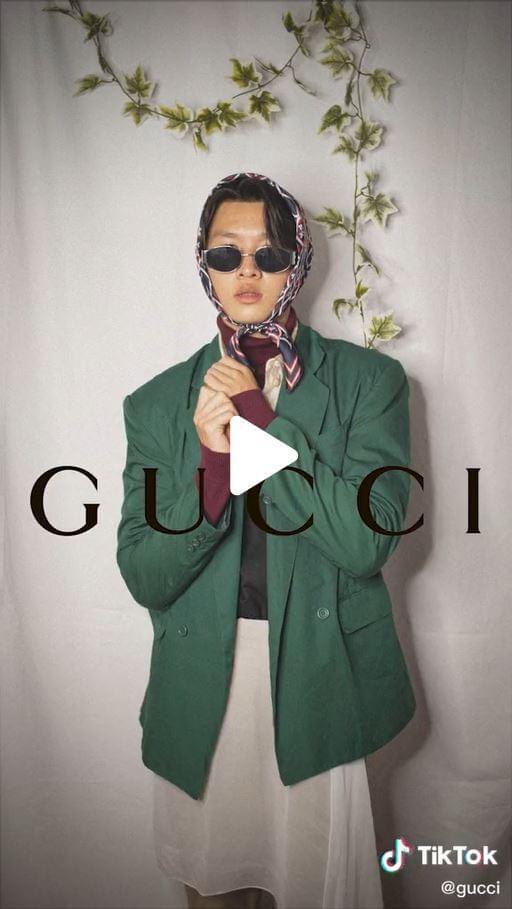
6. Use fashion-related hashtags
Trying to increase the follower count across your fashion brand’s social media accounts? Common sense says that the more followers you have, the more chance you have at turning social media users into customers.
That can be true, but there are other ways to get your content out there to non-followers, including hashtags.
Social media users on certain platforms (like Instagram and TikTok) can follow hashtags and see branded content without following your business’s account. So, if you use the hashtags your target audience is following, your organic content can reach them even if they don’t follow your account.
So, how many hashtags should you use? It depends on the platform. According to Instagram’s latest update, brands should only use anywhere from three to five hashtags for maximum reach. Instagram hashtags like #styleinspo, #jeans, and #swimwear are amongst some of the most used on the platform.
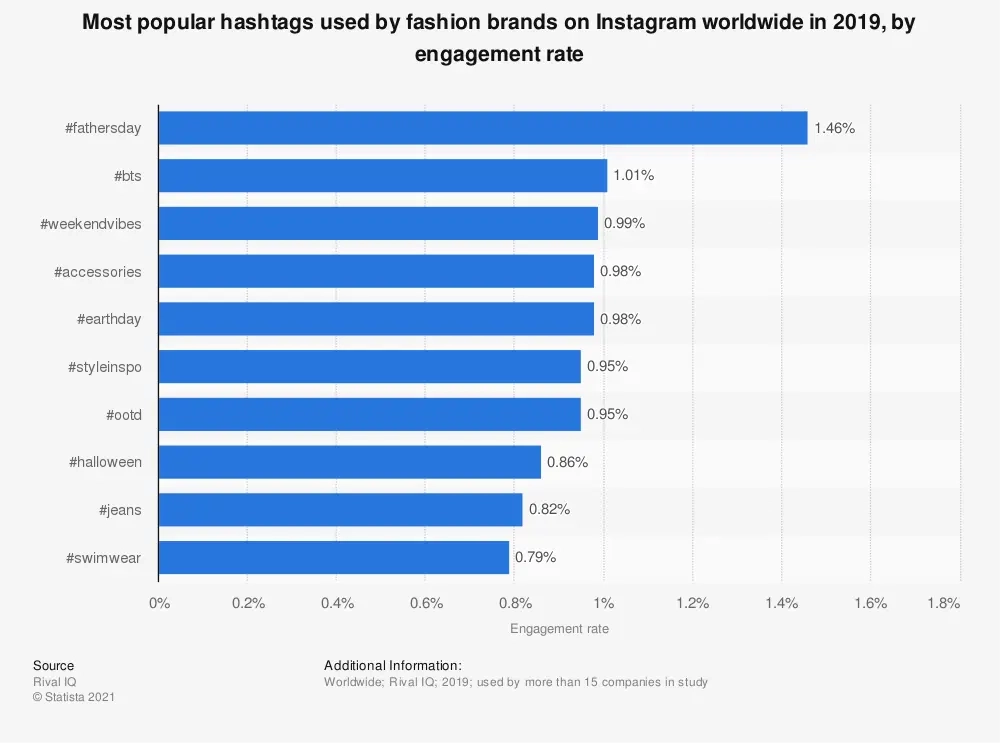
TikTok’s algorithm also uses hashtags to recommend new content to its users. Hashtags like #OOTD, #lookbook, #streetstyle, and #fashionblogger are great for brands wanting to reach users interested in apparel.
Just like you would use SEO on your website to make sure it ranks in Google’s search engine results, using hashtags on TikTok makes you findable to the right people: your target customers.
7. Jump on trending topics or events
Jumping on trends is a solid way for brands to use what’s already working to elevate their brand awareness. After all, fashion relies heavily on trends. The low-rise jeans we wore in the 2000s aren’t today’s best-sellers.
Use tools like Buzzsumo to keep an eye on what your target audience is talking about, and monitor your best-sellers. Both of those things can help you spot fashion trends before you’re too late to the party.
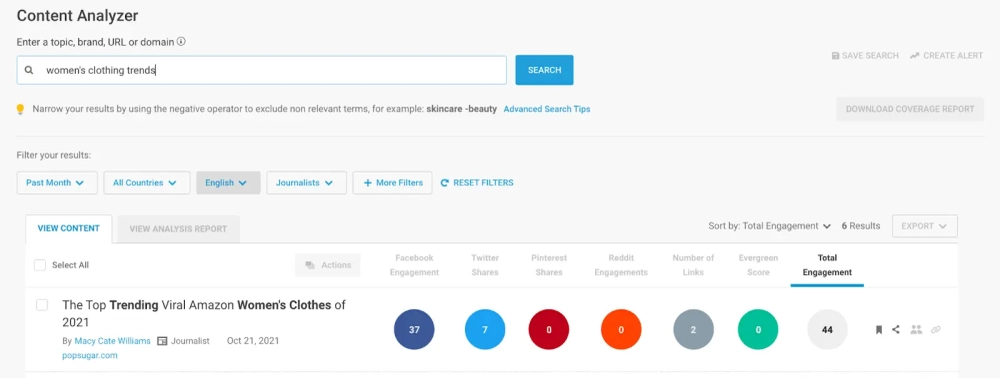
The best part? You don’t have to create this type of trending content yourself. If London Fashion Week is coming up, for example, you can partner with an influencer to create an IG Reel showing your product dupes from designers in London Fashion Week.
Or, if you have the budget, send an influencer to an event and have them vlog the day. It’d give their audience a behind-the-scenes look at one of the biggest fashion events in the world—and your fashion brand would be credited as helping them see it.
Once you have the vlog footage, it’s then a matter of repurposing the content and posting it on the platforms where you get the most reach (which will vary from brand to brand). Trending topics afford your brand relevance by association. Don’t hesitate to take advantage of that!
8. Prioritise customer service
Sure, there are lots of tactics you can use to improve engagement, get more social media followers, and generate sales for your fashion brand. Yet sometimes, going back to the basics can work its own magic.
Enter customer service. The most important customer service factors for fashion customers according to Yotpo? Service, speed, shipping, and price.
But there’s a downside: It’s now the norm for customers to go online to vent about poor service, negative experiences, or subpar treatment.
Prioritise customer service by using social media messaging and live chat as support channels. As many as 64% of people would rather message than pick up the phone to speak to a representative. So ditch the traditional call center approach and train your fashion brand’s social media team to deal with customer service issues.
Pretty Little Thing, for example, has customer service agents manning its Twitter DM inbox:
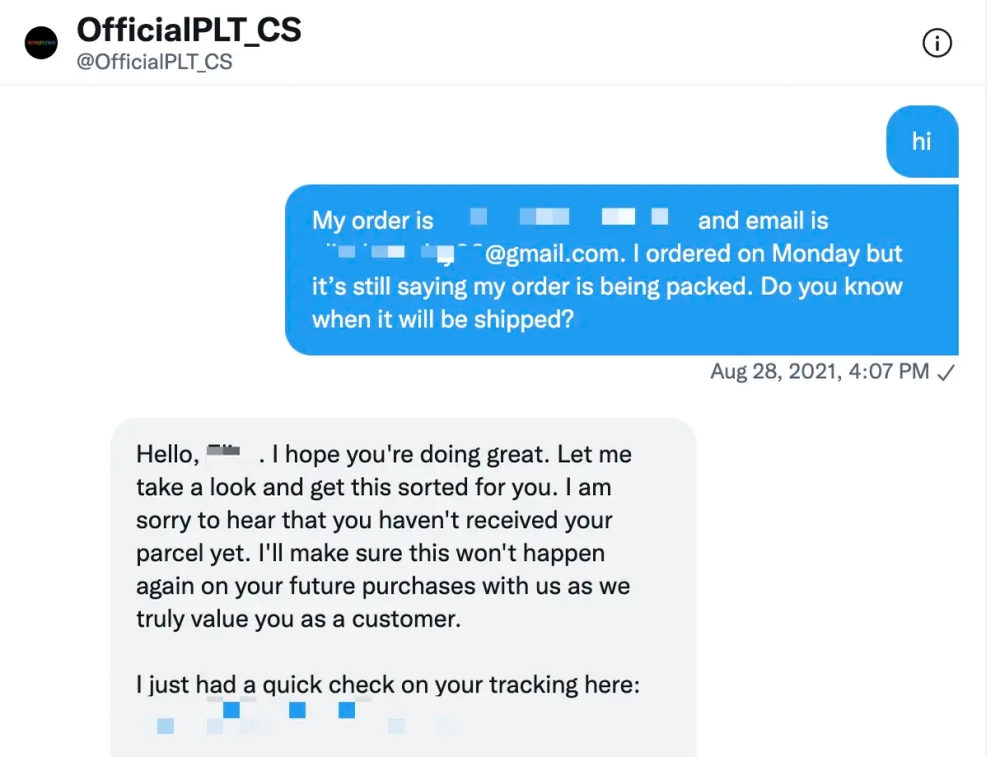
Similarly, prioritise speed when dealing with these direct messages. Dedicate a team member to quickly and positively manage social media messages. As many as 79% of consumers expect a brand to respond within 24 hours—40% within the first hour.
9. Track customer sentiment
Even if you don’t have customers in your social media inbox demanding an update on their order, tracking customer sentiment is a way to keep a finger on the perception of your fashion brand.
Research by McKinsey found that top fashion brands use this type of data analytics to gauge sentiment. They’re also quick to react once they pick up on a trend.
Tools like Mention and Google Alerts show instances of people talking about your fashion brand on social media—even if your account wasn’t tagged in the original post. That way, you can get a solid understanding of how people view your brand, the impression existing customers give to others, and respond to them before they get out of hand.
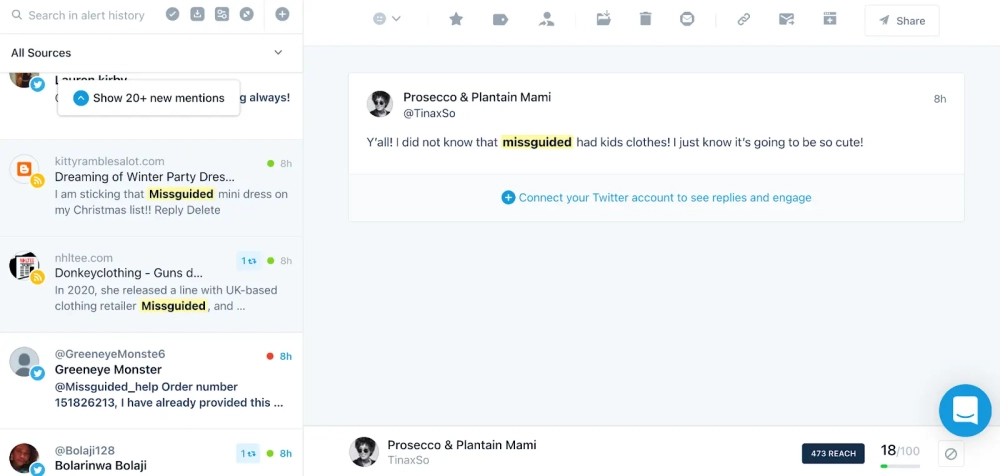
You can also:
Search for hashtags that include your brand name
Diligently track direct feedback through messages, posts, and videos
Pay close attention to the types of posts customers share the most from your social media pages
Use surveys to collect customer insight
Track the tone and sentiments in your social channels that get the highest number of likes
Most negative social media mentions for fashion brands are around issues of sustainability or price. A fashion sentiment analysis run during fashion weeks in London, Paris, Milan, and New York gave marketers insight into growing consumer concerns about sustainability.
This was all done through consumer-driven social media data, which goes on to show how powerful tracking consumer sentiment is for fine-tuning your fashion brand’s social media strategy.
10. Invest in paid ads
You can have the best fashion social media strategy in the world, but you’re still not guaranteed to reach every single person who follows your accounts. Take Facebook, for example, where a post on a brand’s Page reaches just 5.2% of its followers.
Platforms are turning towards the pay-to-play model, hence why many fashion brands invest in advertising across the platforms their target audience is already hanging out.
We worked with Love Leggings, a UK fashion brand, to restructure its ad accounts while maintaining return on advertising spend (ROAS). It wasn’t long before we were able to track fruitful results to the tune of an 8.2 return on ad spend and a 598% year-over-year increase in revenue from paid ads.
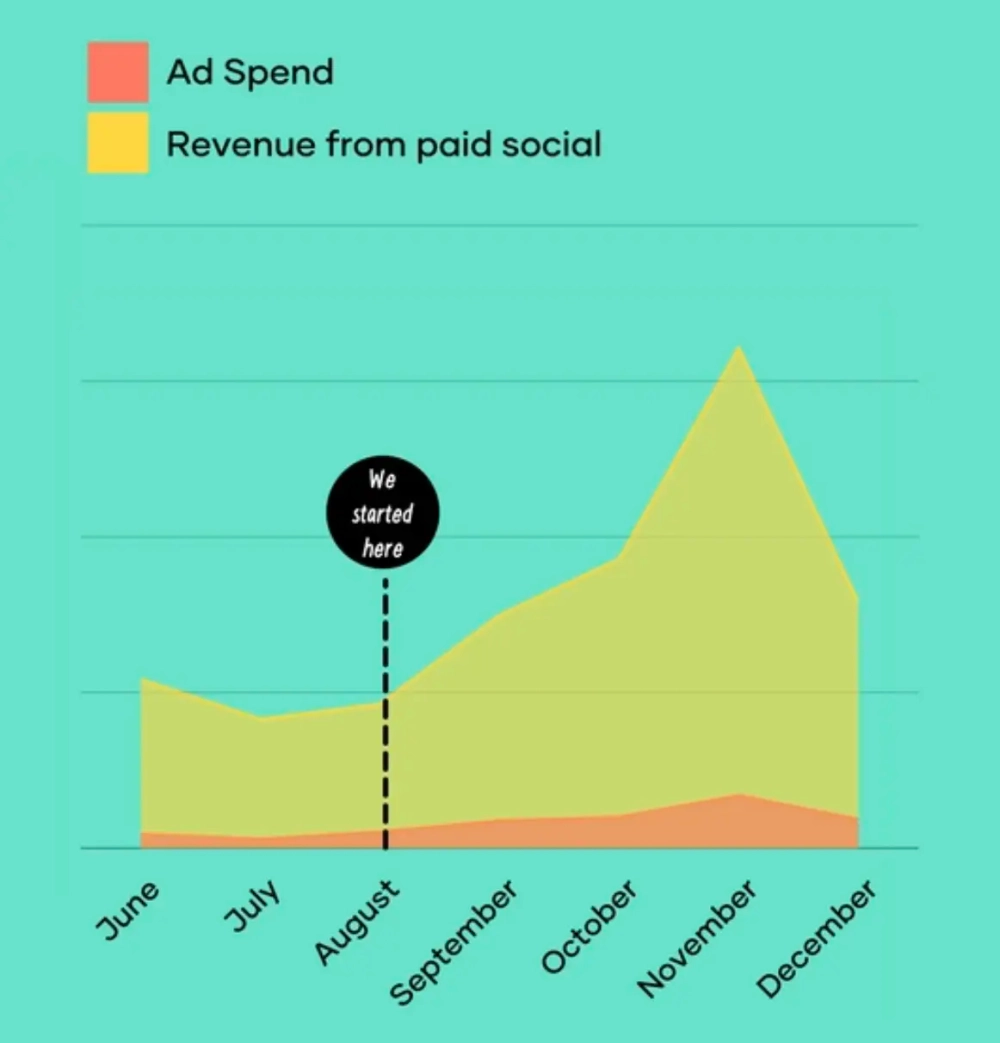
Nu-in, a sustainable clothing brand that targets eco-conscious consumers, also wanted to step up its ad game. With help from our Facebook advertising agency, Nu-In’s campaigns generated over 19,000 purchases and a 30% increase in ROAS.
“The Social Shepherd team understood exactly what I was trying to achieve from the get-go. I can’t praise their attention to detail highly enough. Nothing is too much trouble, and the nu-in team are delighted with the outcome of our campaigns and what we have achieved so far.”
- Leighanne M Akrygiannis, Paid Social and SEO Director
Now we know paid advertising is a valuable channel for fashion brands to reach their target customers through social media, let’s take a look at how your campaigns should be structured.
Targeting
There’s more than one way to target your ideal customers. If you’re using Facebook ads, its algorithm gathers plenty of insights on who your customers are as you create, test, and run your ads. In fact, Facebook gathers as many as 98 different data points on its users to create a highly personalized ad experience.
This includes user location, interests, age, mobile usage, or even interactions with other similar businesses. A fashion brand can target its audience by:
Location. If you have a store in Manchester, choose to show Facebook ads to users within a five-mile radius of the store.
Gender and age. Know that 90% of your customers are men aged 50-70? Use those targeting options in your social media advertising campaigns to prevent wasting your budget on people unlikely to buy.
Interests. If you’re selling horse riding clothes, for example, target Facebook users with an interest in horses.
Affluence. If you’re a luxury eCommerce brand, target Instagram users who follow similar luxury brands to yours.
There’s also the option to retarget social media users based on interactions they’ve had with your brand already. Install the Pixel on your eCommerce website and retarget people who have:
Abandoned their cart
Watched at least half of your Facebook video
Visited your website in the last 30 days but have not purchased
Already purchased (and you want to convince them to do it again)
The final targeting option is a Lookalike Audience, which introduces your fashion brand to a new targeted customer base with similar qualities to your existing customers. It stops you from burning out your current audience with too many ads.
To create a Lookalike audience:
On the Facebook Ads Manager, navigate to your Audiences.
Click on the Create Audience drop-down, then choose Lookalike Audience.
Choose your source (website visitors, mobile app data, Facebook page fans, etc.).
Choose the preferred country you’d like to find that Lookalike audience.
Choose your audience size.
Select Create Audience.
Give the Ads Manager at least 24 hours to create your new audience.
Optimize the ad creative
You run the risk of going down an endless rabbit hole when you’re in the process of optimizing the ad creative. Tweaking your image, ad copy, and messaging can be an endless cycle, but one that needs testing so you can scale the Facebook campaigns that your audience interacts with.
To help, here’s a quick list of ad features worth tweaking and experimenting with to check for more optimized combinations:
Try bold, eye-catching images and darker,r more minimal ones.
Test different ad formats (carousel, single image, canvas, video, etc.).
Use emojis in your ad copy.
Showcase customer reviews or ratings.
Play with CTA options (Click to Messenger, Shop Now, Sign Up Today, etc.).
Your fashion brand needs a social media marketing strategy
As you can see, fashion brands have the ability to tap into existing audiences when promoting their products on social media. But having a social media presence isn’t enough. You need to strategically think about how you’ll build audiences and turn them into paying customers.
Consistency, content, ad budget strategy, and even influencer partnerships need the attention and expertise necessary to bear results. That’s where The Social Shepherd comes in.
As a social media marketing agency, we’ve seen a wide variety of fashion marketing strategies and—through experience—know what’s working now. Save yourself the time and frustration that come with making a go of your fashion social media strategy alone.
Book a free strategy call today and let us help you scale your fashion social media campaigns.

You might also like
Don’t be sheepish
let’s talk


